overheating CHEVROLET DURAMAX 2006 Owners Manual
[x] Cancel search | Manufacturer: CHEVROLET, Model Year: 2006, Model line: DURAMAX, Model: CHEVROLET DURAMAX 2006Pages: 100, PDF Size: 0.71 MB
Page 24 of 100
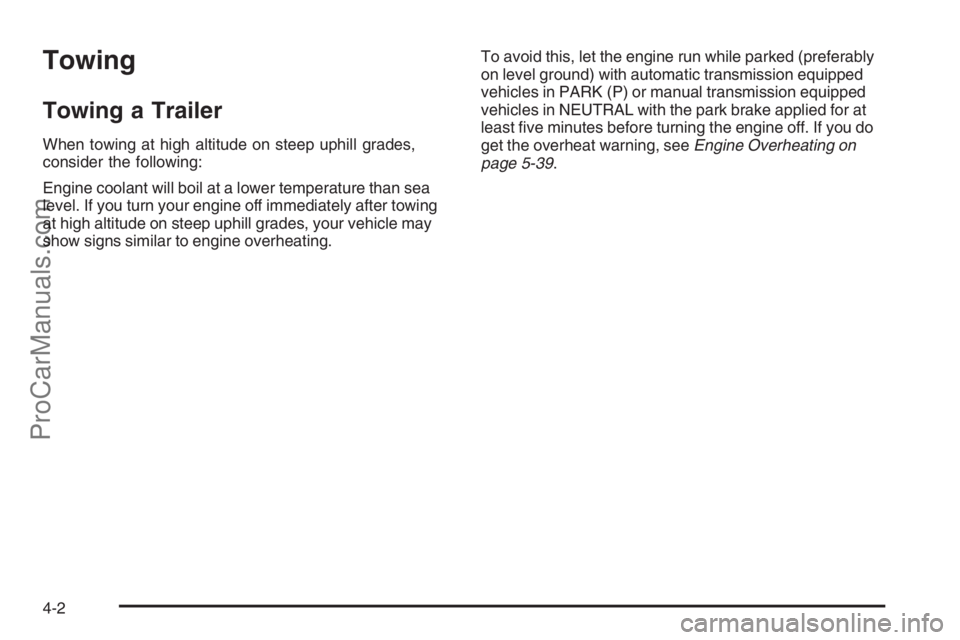
Towing
Towing a Trailer
When towing at high altitude on steep uphill grades,
consider the following:
Engine coolant will boil at a lower temperature than sea
level. If you turn your engine off immediately after towing
at high altitude on steep uphill grades, your vehicle may
show signs similar to engine overheating.To avoid this, let the engine run while parked (preferably
on level ground) with automatic transmission equipped
vehicles in PARK (P) or manual transmission equipped
vehicles in NEUTRAL with the park brake applied for at
least five minutes before turning the engine off. If you do
get the overheat warning, seeEngine Overheating on
page 5-39.
4-2
ProCarManuals.com
Page 25 of 100
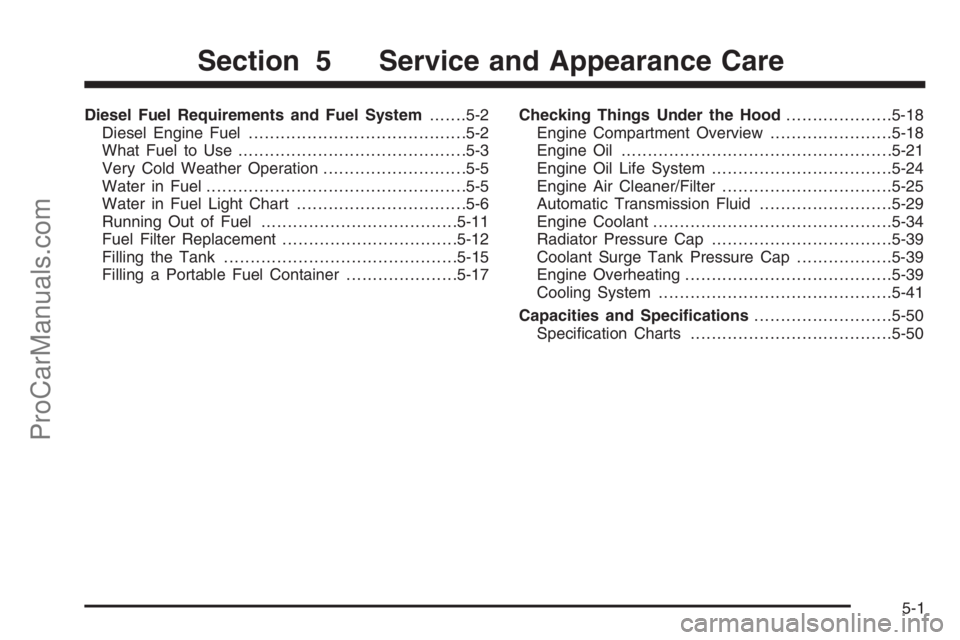
Diesel Fuel Requirements and Fuel System.......5-2
Diesel Engine Fuel.........................................5-2
What Fuel to Use...........................................5-3
Very Cold Weather Operation...........................5-5
Water in Fuel.................................................5-5
Water in Fuel Light Chart................................5-6
Running Out of Fuel.....................................5-11
Fuel Filter Replacement.................................5-12
Filling the Tank............................................5-15
Filling a Portable Fuel Container.....................5-17Checking Things Under the Hood....................5-18
Engine Compartment Overview.......................5-18
Engine Oil...................................................5-21
Engine Oil Life System..................................5-24
Engine Air Cleaner/Filter................................5-25
Automatic Transmission Fluid.........................5-29
Engine Coolant.............................................5-34
Radiator Pressure Cap..................................5-39
Coolant Surge Tank Pressure Cap..................5-39
Engine Overheating.......................................5-39
Cooling System............................................5-41
Capacities and Speci�cations..........................5-50
Specification Charts......................................5-50
Section 5 Service and Appearance Care
5-1
ProCarManuals.com
Page 58 of 100
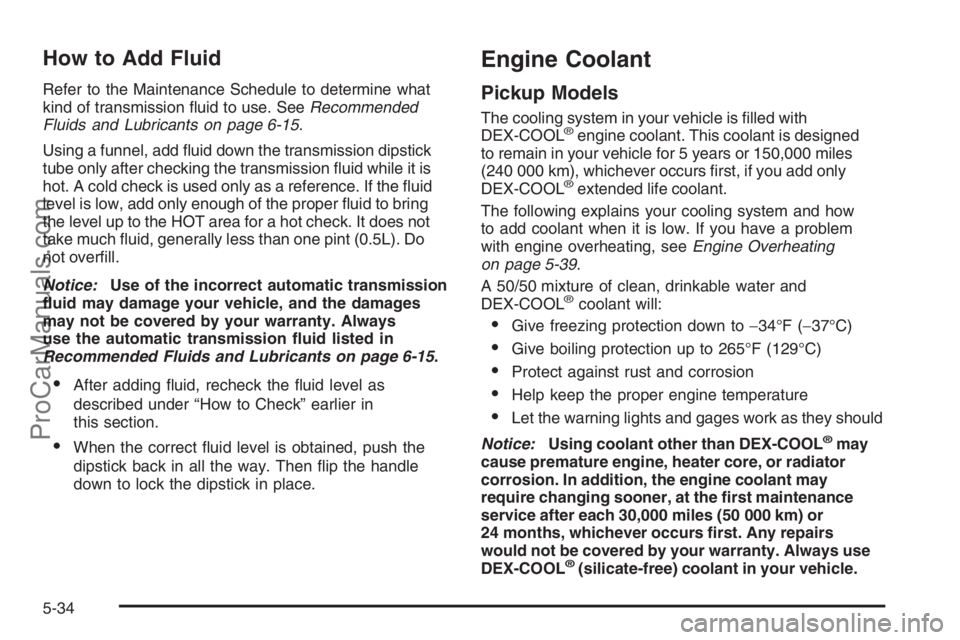
How to Add Fluid
Refer to the Maintenance Schedule to determine what
kind of transmission fluid to use. SeeRecommended
Fluids and Lubricants on page 6-15.
Using a funnel, add fluid down the transmission dipstick
tube only after checking the transmission fluid while it is
hot. A cold check is used only as a reference. If the fluid
level is low, add only enough of the proper fluid to bring
the level up to the HOT area for a hot check. It does not
take much fluid, generally less than one pint (0.5L). Do
not overfill.
Notice:Use of the incorrect automatic transmission
�uid may damage your vehicle, and the damages
may not be covered by your warranty. Always
use the automatic transmission �uid listed in
Recommended Fluids and Lubricants on page 6-15.
•After adding fluid, recheck the fluid level as
described under “How to Check” earlier in
this section.
•When the correct fluid level is obtained, push the
dipstick back in all the way. Then flip the handle
down to lock the dipstick in place.
Engine Coolant
Pickup Models
The cooling system in your vehicle is filled with
DEX-COOL®engine coolant. This coolant is designed
to remain in your vehicle for 5 years or 150,000 miles
(240 000 km), whichever occurs first, if you add only
DEX-COOL
®extended life coolant.
The following explains your cooling system and how
to add coolant when it is low. If you have a problem
with engine overheating, seeEngine Overheating
on page 5-39.
A 50/50 mixture of clean, drinkable water and
DEX-COOL
®coolant will:
•Give freezing protection down to−34°F (−37°C)
•Give boiling protection up to 265°F (129°C)
•Protect against rust and corrosion
•Help keep the proper engine temperature
•Let the warning lights and gages work as they should
Notice:Using coolant other than DEX-COOL
®may
cause premature engine, heater core, or radiator
corrosion. In addition, the engine coolant may
require changing sooner, at the �rst maintenance
service after each 30,000 miles (50 000 km) or
24 months, whichever occurs �rst. Any repairs
would not be covered by your warranty. Always use
DEX-COOL
®(silicate-free) coolant in your vehicle.
5-34
ProCarManuals.com
Page 60 of 100
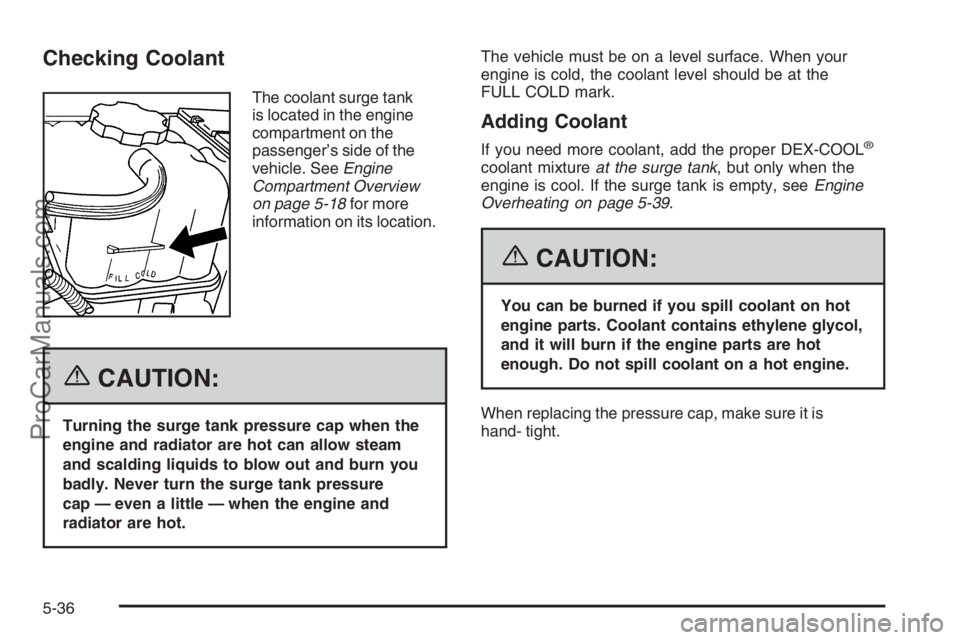
Checking Coolant
The coolant surge tank
is located in the engine
compartment on the
passenger’s side of the
vehicle. SeeEngine
Compartment Overview
on page 5-18for more
information on its location.
{CAUTION:
Turning the surge tank pressure cap when the
engine and radiator are hot can allow steam
and scalding liquids to blow out and burn you
badly. Never turn the surge tank pressure
cap — even a little — when the engine and
radiator are hot.The vehicle must be on a level surface. When your
engine is cold, the coolant level should be at the
FULL COLD mark.
Adding Coolant
If you need more coolant, add the proper DEX-COOL®
coolant mixtureat the surge tank, but only when the
engine is cool. If the surge tank is empty, seeEngine
Overheating on page 5-39.
{CAUTION:
You can be burned if you spill coolant on hot
engine parts. Coolant contains ethylene glycol,
and it will burn if the engine parts are hot
enough. Do not spill coolant on a hot engine.
When replacing the pressure cap, make sure it is
hand- tight.
5-36
ProCarManuals.com
Page 61 of 100
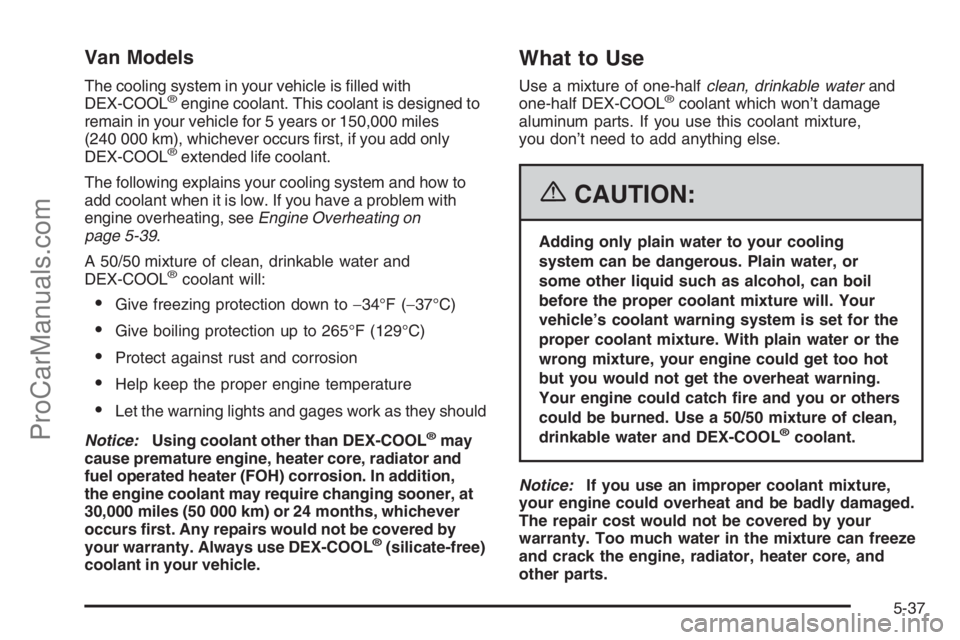
Van Models
The cooling system in your vehicle is filled with
DEX-COOL®engine coolant. This coolant is designed to
remain in your vehicle for 5 years or 150,000 miles
(240 000 km), whichever occurs first, if you add only
DEX-COOL
®extended life coolant.
The following explains your cooling system and how to
add coolant when it is low. If you have a problem with
engine overheating, seeEngine Overheating on
page 5-39.
A 50/50 mixture of clean, drinkable water and
DEX-COOL
®coolant will:
•Give freezing protection down to−34°F (−37°C)
•Give boiling protection up to 265°F (129°C)
•Protect against rust and corrosion
•Help keep the proper engine temperature
•Let the warning lights and gages work as they should
Notice:Using coolant other than DEX-COOL
®may
cause premature engine, heater core, radiator and
fuel operated heater (FOH) corrosion. In addition,
the engine coolant may require changing sooner, at
30,000 miles (50 000 km) or 24 months, whichever
occurs �rst. Any repairs would not be covered by
your warranty. Always use DEX-COOL
®(silicate-free)
coolant in your vehicle.
What to Use
Use a mixture of one-halfclean, drinkable waterand
one-half DEX-COOL®coolant which won’t damage
aluminum parts. If you use this coolant mixture,
you don’t need to add anything else.
{CAUTION:
Adding only plain water to your cooling
system can be dangerous. Plain water, or
some other liquid such as alcohol, can boil
before the proper coolant mixture will. Your
vehicle’s coolant warning system is set for the
proper coolant mixture. With plain water or the
wrong mixture, your engine could get too hot
but you would not get the overheat warning.
Your engine could catch �re and you or others
could be burned. Use a 50/50 mixture of clean,
drinkable water and DEX-COOL
®coolant.
Notice:If you use an improper coolant mixture,
your engine could overheat and be badly damaged.
The repair cost would not be covered by your
warranty. Too much water in the mixture can freeze
and crack the engine, radiator, heater core, and
other parts.
5-37
ProCarManuals.com
Page 63 of 100
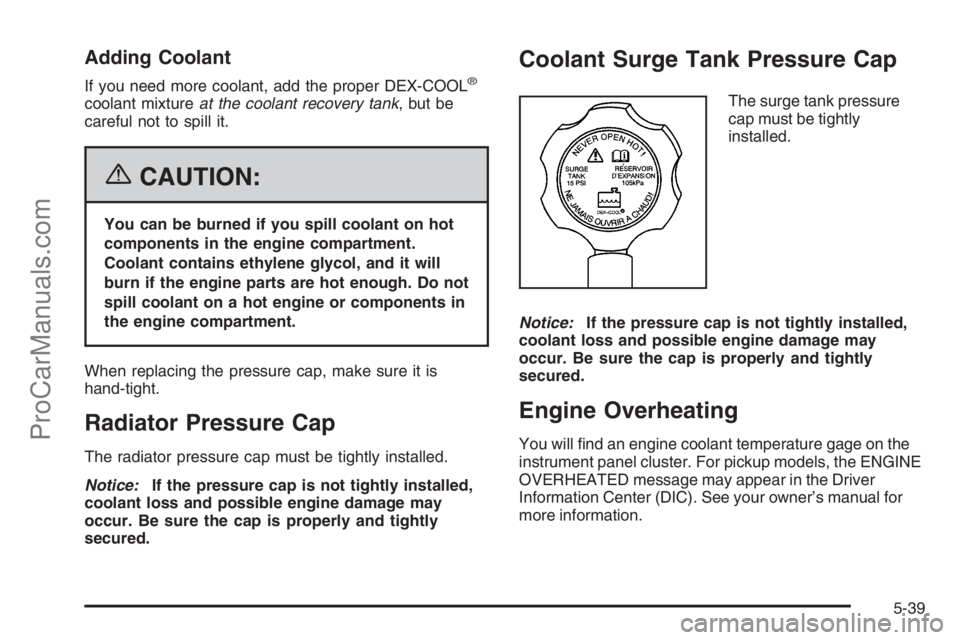
Adding Coolant
If you need more coolant, add the proper DEX-COOL®
coolant mixtureat the coolant recovery tank, but be
careful not to spill it.
{CAUTION:
You can be burned if you spill coolant on hot
components in the engine compartment.
Coolant contains ethylene glycol, and it will
burn if the engine parts are hot enough. Do not
spill coolant on a hot engine or components in
the engine compartment.
When replacing the pressure cap, make sure it is
hand-tight.
Radiator Pressure Cap
The radiator pressure cap must be tightly installed.
Notice:If the pressure cap is not tightly installed,
coolant loss and possible engine damage may
occur. Be sure the cap is properly and tightly
secured.
Coolant Surge Tank Pressure Cap
The surge tank pressure
cap must be tightly
installed.
Notice:If the pressure cap is not tightly installed,
coolant loss and possible engine damage may
occur. Be sure the cap is properly and tightly
secured.
Engine Overheating
You will find an engine coolant temperature gage on the
instrument panel cluster. For pickup models, the ENGINE
OVERHEATED message may appear in the Driver
Information Center (DIC). See your owner’s manual for
more information.
5-39
ProCarManuals.com
Page 97 of 100
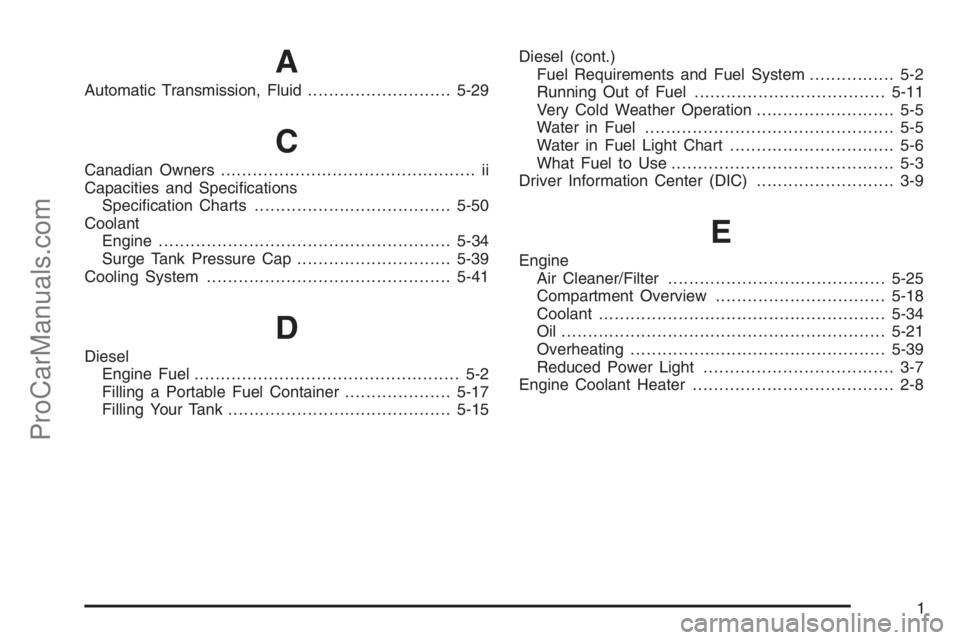
A
Automatic Transmission, Fluid...........................5-29
C
Canadian Owners................................................ ii
Capacities and Specifications
Specification Charts.....................................5-50
Coolant
Engine.......................................................5-34
Surge Tank Pressure Cap.............................5-39
Cooling System..............................................5-41
D
Diesel
Engine Fuel.................................................. 5-2
Filling a Portable Fuel Container....................5-17
Filling Your Tank..........................................5-15Diesel (cont.)
Fuel Requirements and Fuel System................ 5-2
Running Out of Fuel....................................5-11
Very Cold Weather Operation.......................... 5-5
Water in Fuel............................................... 5-5
Water in Fuel Light Chart............................... 5-6
What Fuel to Use.......................................... 5-3
Driver Information Center (DIC).......................... 3-9
E
Engine
Air Cleaner/Filter.........................................5-25
Compartment Overview................................5-18
Coolant......................................................5-34
Oil .............................................................5-21
Overheating................................................5-39
Reduced Power Light.................................... 3-7
Engine Coolant Heater...................................... 2-8
1
ProCarManuals.com
Page 99 of 100
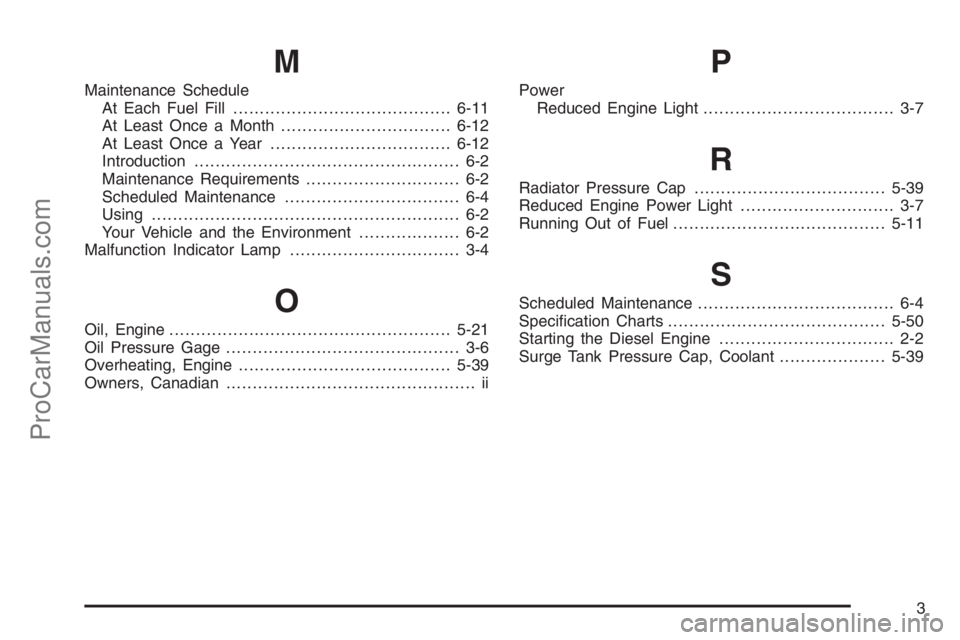
M
Maintenance Schedule
At Each Fuel Fill.........................................6-11
At Least Once a Month................................6-12
At Least Once a Year..................................6-12
Introduction.................................................. 6-2
Maintenance Requirements............................. 6-2
Scheduled Maintenance................................. 6-4
Using.......................................................... 6-2
Your Vehicle and the Environment................... 6-2
Malfunction Indicator Lamp................................ 3-4
O
Oil, Engine.....................................................5-21
Oil Pressure Gage............................................ 3-6
Overheating, Engine........................................5-39
Owners, Canadian............................................... ii
P
Power
Reduced Engine Light.................................... 3-7
R
Radiator Pressure Cap....................................5-39
Reduced Engine Power Light............................. 3-7
Running Out of Fuel........................................5-11
S
Scheduled Maintenance..................................... 6-4
Specification Charts.........................................5-50
Starting the Diesel Engine................................. 2-2
Surge Tank Pressure Cap, Coolant....................5-39
3
ProCarManuals.com